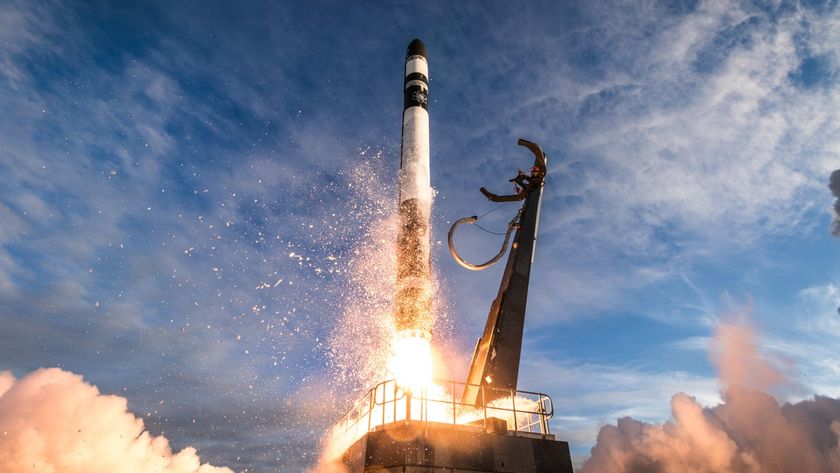Bigelow Aerospace Advances Work On Full-scale Space Habitat
Buildingon lessons they continue to learn from their two space modules still operatingin low Earth orbit, the team at Bigelow Aerospace of North Las Vegas, Nev., isaccelerating its push to get a habitable version launched.
Theinitial focus of that work is Sundancer, a larger version of the subscale Genesis 1and Genesis 2 spacecraft now in orbit. Sundancer willhave 175 cubic meters of habitable space and come fully equipped with lifesupport systems, attitude control, on-orbit maneuvering systems, the ability to reboost itself and,at the end of its life, the ability to conduct a controlled deorbit.It would support a crew of up to three individuals for varying missiondurations and eventually provide the backbone for the first commercial spacestation.
"We'retrying to offer to folks, for multiple kinds of uses, a reliable environmentthat can be used for varying types of purposes. So we're kind of thewholesalers of space," Bigelow Aerospace President Robert Bigelow saidJuly 30 in an exclusive interview with Space News.
"Thisis a little bit like 'if you build it, they will come,'" Bigelow said. Andthey are coming. During the course of the next three months, prospective usersfrom the biotech, pharmaceutical and medical research fields are all slated tovisit the company's Las Vegasfacilities for a look at the progress the company is making on Sundancer, Bigelow said.
Drawingon the cash generated by other companies in his large suite of enterprises ?such as his hotel and real estate businesses ? Bigelow said he had put $150million into Bigelow Aerospace as of April. In 1999, the entrepreneurialBigelow said he was prepared to spend $500 million by 2015. That remains avalid number, he said July 30.
BigelowAerospace announced in May it had inked a nearly $5 million contract with OrionPropulsion Inc. of Huntsville, Ala., to supply the attitude control system forthe forward end of Sundancer. Also that same month,the company announced that Aerojet-General Corp. of Sacramento, Calif.,had been awarded a $23 million deal to supply the propulsion system for the aftend of Sundancer, as well as a system to handlerendezvous and docking.
In addition,Bigelow said the firm's work on life support gear is very encouraging."The testing already indicates we're definitely on the right track,"he said.
Get the Space.com Newsletter
Breaking space news, the latest updates on rocket launches, skywatching events and more!
Sundancer is intended to be a progressive step toward the company'splanned BA-330 orbital habitat, which it intends to make its standard for thefuture. The "330" denotes the cubic meters of that module's internalvolume (11653.8 cubic feet).
Thefirst Bigelow Aerospace space complex would comprise two Sundancer-classmodules, a docking node and propulsion bus combination, as well as a singleBA-330, Bigelow said.
Thecompany already has expanded its sprawling complex of buildings and testfacilities. Work on a new 175,800-square foot (16,335-square meter)structure ? building A3 ? already is under way and scheduled to be completed byDecember 2009. Adjacent to the site is a new nearly 4.9-acre (2-hectare)parking lot.
Bigelowsaid the new facilities are needed to set up an assembly line for producinglarge space modules and associated propulsion buses and docking nodes. "Ourambition and goal for this new building is to be able to handle the fabricationof two full standards per year and one, possibly two, propulsion buses anddocking nodes per year," Bigelow said.
Follow-onfacility
The erection of building A3, and the lessons learned in its creation,are expected to serve as a template for a follow-on facility, perhapssited in a location like Florida, New Mexico, Texas or California perhaps,Bigelow said.
"Insome ways we would prefer being close to our launch facilities. But there couldbe various ways to make it so attractive that locating away from those launchfacilities is advantageous to go ahead and pay for shipping everythingelse," Bigelow said.
"We'renot ready to do this next week. But we know that it's coming," Bigelowcontinued, suggesting that such a plant might offer 484,000 square feet (45,000square meters) of work space. "The quantity of spacecraft we can produceis hugely a function of how much room ? we have to work in."
Bigelowsaid he and his team plan to have two Sundancermodules flight-ready by the end of 2011, as well as a docking node andpropulsion bus system. By the end of 2012, the firm plans to have its firstfull BA-300 standard vessel ready for flight as well. "That's regardlessof whatever happens transportation-wise," he added, referring to thecompany's ongoing search for a suitable launcher to get its hardware intoorbit.
The planis to have at least six launches in one year. "When we start to rock androll, we need to really move out," Bigelow explained. The intent of thecompany is to bundle the purchasing of six launchers, both medium-lifters and aheavy-lifter, to loft all elements of their first commercial space complex,including crew and cargo.
Alsounder way is expansion of a global network of ground stations. Four nodes arenow in operation monitoring the Genesis 1 and Genesis2. With the prospect that human occupation of the first private spacecomplex is possible within five years, perhaps as many as 10 ground stationsare being considered, Bigelow said.
TheGenesis 1 and Genesis 2 modules were placed into orbit July 12, 2006, and June28, 2007, respectively, via Dnepr boosters from the ISC KosmotrasYasny Cosmodrome, locatedin the Orenburg region of Russia. Bothspacecraft remain in excellent shape, demonstrating the viability of expandablestructures in Earth orbit, Bigelow said.
Whileenthusiastic about his space module work, boosting his space venture into orbitremains a wearisome matter, Bigelow said. What he wants to avoid is devotingmoney to fighting a two-front war, he said. That is, spending his resources ondestination and devoting capital to transportation. "If we don't do that,we're going to be OK."
Whatbothers Bigelow about boosters is, "If we're going to put our clients onboosters, I want to damn well be sure that there's significant amount ofseconds on testing of a motor configuration," he said.
"Iapplaud the efforts of Lockheed Martin ? and the efforts of [Space ExplorationTechnologies Corp.]," he added, in terms of U.S. booster capability. "Wewould like to see a time when there's not a single [launch] supplier in the U.S., much lessworldwide."
"Thecrew transportation issue is certainly challenging, and it keeps me up at nightmore often than my infant son ? and that's saying something," said MikeGold, director of Bigelow Aerospace's Washingtonoffice. However, there is hope, he added.
"Wehave been and are in discussions with a number of entities, old and new, largeand small, about crew transportation. We're looking at a variety of ideas fromtraditional to innovative, and while certainly all of our options are stillopen, some progress has been made," Gold told Space News in an Aug. 1e-mail.
Gold said that, ideally, the successof Genesis 1 and 2, the ongoing construction of Sundancer,coupled with the overall financial and technological commitment BigelowAerospace has made to expandable space habitats "will help act as anincentive toward the development of affordable and reliable low Earth orbitcrew transportation systems."
Join our Space Forums to keep talking space on the latest missions, night sky and more! And if you have a news tip, correction or comment, let us know at: community@space.com.

Leonard David is an award-winning space journalist who has been reporting on space activities for more than 50 years. Currently writing as Space.com's Space Insider Columnist among his other projects, Leonard has authored numerous books on space exploration, Mars missions and more, with his latest being "Moon Rush: The New Space Race" published in 2019 by National Geographic. He also wrote "Mars: Our Future on the Red Planet" released in 2016 by National Geographic. Leonard has served as a correspondent for SpaceNews, Scientific American and Aerospace America for the AIAA. He has received many awards, including the first Ordway Award for Sustained Excellence in Spaceflight History in 2015 at the AAS Wernher von Braun Memorial Symposium. You can find out Leonard's latest project at his website and on Twitter.











